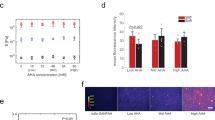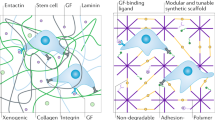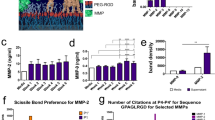Abstract
A major obstacle in defining the exact role of extracellular matrix (ECM) in stem cell niches is the lack of suitable in vitro methods that recapitulate complex ECM microenvironments. Here we describe a methodology that permits reliable anchorage of native cell–secreted ECM to culture carriers. We validated our approach by fabricating two types of human bone marrow–specific ECM substrates that were robust enough to support human mesenchymal stem cells (MSCs) and hematopoietic stem and progenitor cells in vitro. We characterized the molecular composition, structural features and nanomechanical properties of the MSC-derived ECM preparations and demonstrated their ability to support expansion and differentiation of bone marrow stem cells. Our methodology enables the deciphering and modulation of native-like multicomponent ECMs of tissue-resident stem cells and will therefore prepare the ground for a more rational design of engineered stem cell niches.
This is a preview of subscription content, access via your institution
Access options
Subscribe to this journal
Receive 12 print issues and online access
$259.00 per year
only $21.58 per issue
Buy this article
- Purchase on Springer Link
- Instant access to full article PDF
Prices may be subject to local taxes which are calculated during checkout





Similar content being viewed by others
References
Schofield, R. The relationship between the spleen colony-forming cell and the haemopoietic stem cell. Blood Cells 4, 7–25 (1978).
Wang, L.D. & Wagers, A.J. Dynamic niches in the origination and differentiation of haematopoietic stem cells. Nat. Rev. Mol. Cell Biol. 12, 643–655 (2011).
Discher, D.E., Mooney, D.J. & Zandstra, P.W. Growth factors, matrices, and forces combine and control stem cells. Science 324, 1673–1677 (2009).
Engler, A.J., Sen, S., Sweeney, H.L. & Discher, D.E. Matrix elasticity directs stem cell lineage specification. Cell 126, 677–689 (2006).
Holst, J. et al. Substrate elasticity provides mechanical signals for the expansion of hemopoietic stem and progenitor cells. Nat. Biotechnol. 28, 1123–1128 (2010).
Gupta, P. et al. Structurally specific heparan sulfates support primitive human hematopoiesis by formation of a multimolecular stem cell niche. Blood 92, 4641–4651 (1998).
Coulombel, L., Vuillet, M.H., Leroy, C. & Tchernia, G. Lineage- and stage-specific adhesion of human hematopoietic progenitor cells to extracellular matrices from marrow fibroblasts. Blood 71, 329–334 (1988).
Seib, F.P. et al. Engineered extracellular matrices modulate the expression profile and feeder properties of bone marrow-derived human multipotent mesenchymal stromal cells. Tissue Eng. Part A 15, 3161–3171 (2009).
Chen, X.-D., Dusevich, V., Feng, J.Q., Manolagas, S.C. & Jilka, R.L. Extracellular matrix made by bone marrow cells facilitates expansion of marrow-derived mesenchymal progenitor cells and prevents their differentiation into osteoblasts. J. Bone Miner. Res. 22, 1943–1956 (2007).
Klimanskaya, I. et al. Human embryonic stem cells derived without feeder cells. Lancet 365, 1636–1641 (2005).
Cukierman, E., Pankov, R., Stevens, D.R. & Yamada, K.M. Taking cell-matrix adhesions to the third dimension. Science 294, 1708–1712 (2001).
Vlodavsky, I. Preparation of extracellular matrices produced by cultured corneal endothelial and PF-HR9 endodermal cells. Curr. Protoc. Cell Biol. 1, 10.4 (2001).
Beacham, D.A., Amatangelo, M.D. & Cukierman, E. Preparation of extracellular matrices produced by cultured and primary fibroblasts. Curr. Protoc. Cell Biol. 33, 10.9 (2007).
Calvi, L.M. et al. Osteoblastic cells regulate the haematopoietic stem cell niche. Nature 425, 841–846 (2003).
Méndez-Ferrer, S. et al. Mesenchymal and haematopoietic stem cells form a unique bone marrow niche. Nature 466, 829–834 (2010).
Pompe, T. et al. Maleic anhydride copolymers—a versatile platform for molecular biosurface engineering. Biomacromolecules 4, 1072–1079 (2003).
Gordon, M.Y. Extracellular matrix of the marrow microenvironment. Br. J. Haematol. 70, 1–4 (1988).
Ren, J. et al. Global transcriptome analysis of human bone marrow stromal cells (BMSC) reveals proliferative, mobile and interactive cells that produce abundant extracellular matrix proteins, some of which may affect BMSC potency. Cytotherapy 13, 661–674 (2011).
Lanfer, B. et al. The growth and differentiation of mesenchymal stem and progenitor cells cultured on aligned collagen matrices. Biomaterials 30, 5950–5958 (2009).
Shultz, L.D., Ishikawa, F. & Greiner, D.L. Humanized mice in translational biomedical research. Nat. Rev. Immunol. 7, 118–130 (2007).
Eppert, K. et al. Stem cell gene expression programs influence clinical outcome in human leukemia. Nat. Med. 17, 1086–1093 (2011).
Flaim, C.J., Chien, S. & Bhatia, S.N. An extracellular matrix microarray for probing cellular differentiation. Nat. Methods 2, 119–125 (2005).
Ehninger, A. & Trumpp, A. The bone marrow stem cell niche grows up: mesenchymal stem cells and macrophages move in. J. Exp. Med. 208, 421–428 (2011).
Bianco, P., Robey, P.G. & Simmons, P.J. Mesenchymal stem cells: revisiting history, concepts, and assays. Cell Stem Cell 2, 313–319 (2008).
Dexter, T.M., Spooncer, E., Simmons, P. & Allen, T.D. Long-term marrow culture: an overview of techniques and experience. Kroc Found. Ser. 18, 57–96 (1984).
Baxter, M.A. et al. Study of telomere length reveals rapid aging of human marrow stromal cells following in vitro expansion. Stem Cells 22, 675–682 (2004).
Wagner, W. et al. Replicative senescence of mesenchymal stem cells: a continuous and organized process. PLoS ONE 3, e2213 (2008).
Matsubara, T. et al. A new technique to expand human mesenchymal stem cells using basement membrane extracellular matrix. Biochem. Biophys. Res. Commun. 313, 503–508 (2004).
Mauney, J.R., Volloch, V. & Kaplan, D.L. Matrix-mediated retention of adipogenic differentiation potential by human adult bone marrow-derived mesenchymal stem cells during ex vivo expansion. Biomaterials 26, 6167–6175 (2005).
Chen, X.-D. Extracellular matrix provides an optimal niche for the maintenance and propagation of mesenchymal stem cells. Birth Defects Res. C Embryo Today 90, 45–54 (2010).
Sun, Y. et al. Rescuing replication and osteogenesis of aged mesenchymal stem cells by exposure to a young extracellular matrix. FASEB J. 25, 1474–1485 (2011).
Bruckner, P. Suprastructures of extracellular matrices: paradigms of functions controlled by aggregates rather than molecules. Cell Tissue Res. 339, 7–18 (2010).
Hines, M., Nielsen, L. & Cooper-White, J. The hematopoietic stem cell niche: what are we trying to replicate? J. Chem. Technol. Biotechnol. 83, 421–443 (2008).
Lapidot, T. & Kollet, O. The essential roles of the chemokine SDF-1 and its receptor CXCR4 in human stem cell homing and repopulation of transplanted immune-deficient NOD/SCID and NOD/SCID/B2mnull mice. Leukemia 16, 1992–2003 (2002).
Fleming, H.E. et al. Wnt signaling in the niche enforces hematopoietic stem cell quiescence and is necessary to preserve self-renewal in vivo. Cell Stem Cell 2, 274–283 (2008).
Janowska-Wieczorek, A., Majka, M., Ratajczak, J. & Ratajczak, M.Z. Autocrine/paracrine mechanisms in human hematopoiesis. Stem Cells 19, 99–107 (2001).
Tsuji, K., Ueda, T. & Ebihara, Y. Cytokine-mediated expansion of human NOD-SCID-repopulating cells. Methods Mol. Biol. 215, 387–395 (2003).
Alakel, N. et al. Direct contact with mesenchymal stromal cells affects migratory behavior and gene expression profile of CD133+ hematopoietic stem cells during ex vivo expansion. Exp. Hematol. 37, 504–513 (2009).
Kurth, I., Franke, K., Pompe, T., Bornhäuser, M. & Werner, C. Hematopoietic stem and progenitor cells in adhesive microcavities. Integr. Biol. (Camb.) 1, 427–434 (2009).
Franke, K., Pompe, T., Bornhäuser, M. & Werner, C. Engineered matrix coatings to modulate the adhesion of CD133+ human hematopoietic progenitor cells. Biomaterials 28, 836–843 (2007).
Melkoumian, Z. et al. Synthetic peptide-acrylate surfaces for long-term self-renewal and cardiomyocyte differentiation of human embryonic stem cells. Nat. Biotechnol. 28, 606–610 (2010).
Rodin, S. et al. Long-term self-renewal of human pluripotent stem cells on human recombinant laminin-511. Nat. Biotechnol. 28, 611–615 (2010).
Lanfer, B. et al. Aligned fibrillar collagen matrices obtained by shear flow deposition. Biomaterials 29, 3888–3895 (2008).
Oswald, J. et al. Mesenchymal stem cells can be differentiated into endothelial cells in vitro. Stem Cells 22, 377–384 (2004).
Gilbert, T.W., Sellaro, T.L. & Badylak, S.F. Decellularization of tissues and organs. Biomaterials 27, 3675–3683 (2006).
Pittenger, M.F., Mbalaviele, G., Black, M., Mosca, J.D. & Marshak, D.R. Mesenchymal stem cells. in Human Cell Culture Vol. 5 (eds. Koller, M.R., Palsson, B.O. & Masters, J.R.W.) Ch. 9, 189–207 (Kluwer, 2001).
Sen, A. et al. Adipogenic potential of human adipose derived stromal cells from multiple donors is heterogeneous. J. Cell. Biochem. 81, 312–319 (2001).
Waskow, C. et al. The receptor tyrosine kinase Flt3 is required for dendritic cell development in peripheral lymphoid tissues. Nat. Immunol. 9, 676–683 (2008).
Wight, T.N., Kinsella, M.G., Keating, A. & Singer, J.W. Proteoglycans in human long-term bone marrow cultures: biochemical and ultrastructural analyses. Blood 67, 1333–1343 (1986).
Hutter, J.L. & Bechhoefer, J. Calibration of atomic-force microscope tips. Rev. Sci. Instrum. 64, 1868–1873 (1993).
Krieg, M. et al. Tensile forces govern germ-layer organization in zebrafish. Nat. Cell Biol. 10, 429–436 (2008).
Shevchenko, A., Tomas, H., Havlis, J., Olsen, J.V. & Mann, M. In-gel digestion for mass spectrometric characterization of proteins and proteomes. Nat. Protoc. 1, 2856–2860 (2006).
Cox, J. & Mann, M. MaxQuant enables high peptide identification rates, individualized p.p.b.-range mass accuracies and proteome-wide protein quantification. Nat. Biotechnol. 26, 1367–1372 (2008).
Hubner, N.C. & Mann, M. Extracting gene function from protein-protein interactions using Quantitative BAC InteraCtomics (QUBIC). Methods 53, 453–459 (2011).
Acknowledgements
The authors thank A. Springer for help with electron microscopy analysis and K. Schneider and K. Heidel for technical assistance. This work was supported by the Deutsche Forschungsgemeinschaft within the Collaborative Research Center “From Cells to Tissues” SFB 655 (A12/B2, M.v.B. and C. Werner; B9, C. Waskow) and by the Research Consortium SkelMet (M.v.B.). F.P.S. was supported by a Mildred Scheel Postdoctoral fellowship from the German Cancer Aid, and M.v.B. was supported by the German Cancer Consortium and by the German Cancer Research Center.
Author information
Authors and Affiliations
Contributions
M.C.P. designed and performed experiments, analyzed data and wrote the manuscript; F.P.S. designed experiments and cosupervised parts of the study; M.v.B. designed, performed and analyzed transplantation experiments together with M.C.P.; C. Waskow established the transplantation experiments; J.F. performed and analyzed AFM measurements; A.S. performed experiments; K.M. isolated primary human MSCs; C.N. and B.H. performed mass spectroscopy and analyzed the proteomics data; K.A. gave conceptual advice; M.B. and C. Werner initiated and supervised the study and edited the manuscript.
Corresponding author
Ethics declarations
Competing interests
The authors declare no competing financial interests.
Supplementary information
Supplementary Text and Figures
Supplementary Figures 1–7 and Supplementary Table 1 (PDF 5477 kb)
Supplementary Data
Excel list of all detected proteins via Orbitrap mass spectrometry. Each mass spectrometrically analyzed sample comprises the pool of five different MSC-donor ECM extracts (for aaECM and osteoECM respectively). Data represent three independent experiments. (XLSX 406 kb)
Time-lapse visualization of MSC behavior in contact with aaECM
Time-lapse recordings of MSC in contact with aaECM for a total duration of 89 hours, starting from day 1 in culture. MSC align and migrate along the underlying ECM fibrillar structures. Several events of cell division can be observed during the recorded time frame. Scale bar at 100 μm. (MP4 5324 kb)
Time-lapse visualization of MSC behavior in contact with osteoECM
Time-lapse recordings of MSC in contact with osteoECM for a total duration of 89 hours, starting from day 1 in culture. MSC align and migrate along the underlying ECM fibrillar structures and actively pull and rearrange the matrix fibers. Several events of cell division can be observed during the recorded time frame. Scale bars at 100 μm. (MP4 5315 kb)
Time-lapse visualization of MSC behavior in contact with PTP
Time-lapse recordings of MSC in contact with PTP for a total duration of 89 hours, starting from day 1 in culture. MSC demonstrate very polygonal shaped morphology and make wide spread contacts with the underlying surface, thereby generating cytoskeletal stress fibers and long cell protrusions to contact other neighboring cells. Scale bars at 100 μm. (MP4 5640 kb)
Rights and permissions
About this article
Cite this article
Prewitz, M., Seib, F., von Bonin, M. et al. Tightly anchored tissue-mimetic matrices as instructive stem cell microenvironments. Nat Methods 10, 788–794 (2013). https://doi.org/10.1038/nmeth.2523
Received:
Accepted:
Published:
Issue Date:
DOI: https://doi.org/10.1038/nmeth.2523
This article is cited by
-
Blockade of TGF-β signalling alleviates human adipose stem cell senescence induced by native ECM in obesity visceral white adipose tissue
Stem Cell Research & Therapy (2023)
-
Inhibition of lysyl oxidases synergizes with 5-azacytidine to restore erythropoiesis in myelodysplastic and myeloid malignancies
Nature Communications (2023)
-
Decellularized extracellular matrix mediates tissue construction and regeneration
Frontiers of Medicine (2022)
-
Aspirin mediates histone methylation that inhibits inflammation-related stemness gene expression to diminish cancer stemness via COX-independent manner
Stem Cell Research & Therapy (2020)
-
Ibuprofen mediates histone modification to diminish cancer cell stemness properties via a COX2-dependent manner
British Journal of Cancer (2020)



